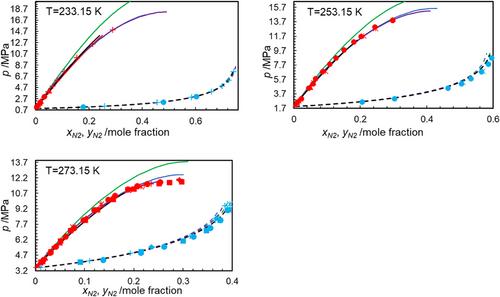下载PDF
{"title":"用于富含二氧化碳的二元混合物在低温下的相行为建模的三次方程混合规则和多流体舵霍兹能量近似方程的验证","authors":"Franklin Okoro, Antonin Chapoy, Pezhman Ahmadi, Rod Burgass","doi":"10.1002/ghg.2300","DOIUrl":null,"url":null,"abstract":"<p>The transportation of CO<sub>2</sub> from the capture site to the storage location is a crucial phase in carbon capture, utilisation and storage (CCUS) process. For offshore operations, ship transportation is considered a viable alternative, and this would entail operations at low temperatures (down to 223.15 K). A review of the literature revealed that there is limited experimental data on CO<sub>2</sub>-rich systems at low temperatures, thus, the need to investigate the phase behaviour of CO<sub>2</sub>-rich systems at these conditions. This study validated and compared the accuracies of Peng–Robinson (PR) equation of state (EoS) with three different mixing rules (the classical with original and adjusted binary interaction parameters, the Wong–Sandler, and the Orbey–Wong–Sandler mixing rules) against the multi-fluid helmholtz energy approximation (MFHEA - with original and adjusted binary-specific reducing parameters) EoS in the prediction of bubble points of CO<sub>2</sub>-rich binary systems (CO<sub>2</sub>-CH<sub>4</sub>, CO<sub>2</sub>–O<sub>2</sub>, CO<sub>2</sub>–Ar, and CO<sub>2</sub>–N<sub>2</sub>) for CCUS applications. The experimental studies used for the validation of the models were conducted at low temperatures (228.15–273.15 K with overall uncertainties of 0.14 K) and for five different CO<sub>2</sub> mole ratios (99.5, 99, 98.5, 98 and 95% with overall uncertainties of 0.032%) using the constant composition expansion method. The overall uncertainty of the pressure measurements was 0.03 MPa. From the study, it was observed that there was a significant effect of binary interaction parameters (BIP) adjustment on the performance of PR-EoS with classical mixing rule, especially for the CO<sub>2</sub>–N<sub>2</sub> system. For all the systems, the predictions of PR-EoS with the classical mixing rules and the adjusted BIPs were the most accurate in terms of the average absolute deviations from the experimental data. The model also predicted the literature data well in comparison with the other models (with less than 5% deviations for all the data points). Further analysis also proved that the model dew point predictions were in reasonable agreement with the available literature data at the considered conditions. As a result, the model could be adopted to fill the existing knowledge gaps of the studied systems at conditions (143.15–223.15 K) where experimental studies were not feasible. © 2024 The Author(s). <i>Greenhouse Gases: Science and Technology</i> published by Society of Chemical Industry and John Wiley & Sons Ltd.</p>","PeriodicalId":12796,"journal":{"name":"Greenhouse Gases: Science and Technology","volume":"14 5","pages":"829-858"},"PeriodicalIF":2.8000,"publicationDate":"2024-08-15","publicationTypes":"Journal Article","fieldsOfStudy":null,"isOpenAccess":false,"openAccessPdf":"https://onlinelibrary.wiley.com/doi/epdf/10.1002/ghg.2300","citationCount":"0","resultStr":"{\"title\":\"Validation of cubic EoS mixing rules and multi-fluid helmholtz energy approximation EoS for the phase behaviour modelling of CO2-rich binary mixtures at low temperatures\",\"authors\":\"Franklin Okoro, Antonin Chapoy, Pezhman Ahmadi, Rod Burgass\",\"doi\":\"10.1002/ghg.2300\",\"DOIUrl\":null,\"url\":null,\"abstract\":\"<p>The transportation of CO<sub>2</sub> from the capture site to the storage location is a crucial phase in carbon capture, utilisation and storage (CCUS) process. For offshore operations, ship transportation is considered a viable alternative, and this would entail operations at low temperatures (down to 223.15 K). A review of the literature revealed that there is limited experimental data on CO<sub>2</sub>-rich systems at low temperatures, thus, the need to investigate the phase behaviour of CO<sub>2</sub>-rich systems at these conditions. This study validated and compared the accuracies of Peng–Robinson (PR) equation of state (EoS) with three different mixing rules (the classical with original and adjusted binary interaction parameters, the Wong–Sandler, and the Orbey–Wong–Sandler mixing rules) against the multi-fluid helmholtz energy approximation (MFHEA - with original and adjusted binary-specific reducing parameters) EoS in the prediction of bubble points of CO<sub>2</sub>-rich binary systems (CO<sub>2</sub>-CH<sub>4</sub>, CO<sub>2</sub>–O<sub>2</sub>, CO<sub>2</sub>–Ar, and CO<sub>2</sub>–N<sub>2</sub>) for CCUS applications. The experimental studies used for the validation of the models were conducted at low temperatures (228.15–273.15 K with overall uncertainties of 0.14 K) and for five different CO<sub>2</sub> mole ratios (99.5, 99, 98.5, 98 and 95% with overall uncertainties of 0.032%) using the constant composition expansion method. The overall uncertainty of the pressure measurements was 0.03 MPa. From the study, it was observed that there was a significant effect of binary interaction parameters (BIP) adjustment on the performance of PR-EoS with classical mixing rule, especially for the CO<sub>2</sub>–N<sub>2</sub> system. For all the systems, the predictions of PR-EoS with the classical mixing rules and the adjusted BIPs were the most accurate in terms of the average absolute deviations from the experimental data. The model also predicted the literature data well in comparison with the other models (with less than 5% deviations for all the data points). Further analysis also proved that the model dew point predictions were in reasonable agreement with the available literature data at the considered conditions. As a result, the model could be adopted to fill the existing knowledge gaps of the studied systems at conditions (143.15–223.15 K) where experimental studies were not feasible. © 2024 The Author(s). <i>Greenhouse Gases: Science and Technology</i> published by Society of Chemical Industry and John Wiley & Sons Ltd.</p>\",\"PeriodicalId\":12796,\"journal\":{\"name\":\"Greenhouse Gases: Science and Technology\",\"volume\":\"14 5\",\"pages\":\"829-858\"},\"PeriodicalIF\":2.8000,\"publicationDate\":\"2024-08-15\",\"publicationTypes\":\"Journal Article\",\"fieldsOfStudy\":null,\"isOpenAccess\":false,\"openAccessPdf\":\"https://onlinelibrary.wiley.com/doi/epdf/10.1002/ghg.2300\",\"citationCount\":\"0\",\"resultStr\":null,\"platform\":\"Semanticscholar\",\"paperid\":null,\"PeriodicalName\":\"Greenhouse Gases: Science and Technology\",\"FirstCategoryId\":\"93\",\"ListUrlMain\":\"https://scijournals.onlinelibrary.wiley.com/doi/10.1002/ghg.2300\",\"RegionNum\":4,\"RegionCategory\":\"环境科学与生态学\",\"ArticlePicture\":[],\"TitleCN\":null,\"AbstractTextCN\":null,\"PMCID\":null,\"EPubDate\":\"\",\"PubModel\":\"\",\"JCR\":\"Q3\",\"JCRName\":\"ENERGY & FUELS\",\"Score\":null,\"Total\":0}","platform":"Semanticscholar","paperid":null,"PeriodicalName":"Greenhouse Gases: Science and Technology","FirstCategoryId":"93","ListUrlMain":"https://scijournals.onlinelibrary.wiley.com/doi/10.1002/ghg.2300","RegionNum":4,"RegionCategory":"环境科学与生态学","ArticlePicture":[],"TitleCN":null,"AbstractTextCN":null,"PMCID":null,"EPubDate":"","PubModel":"","JCR":"Q3","JCRName":"ENERGY & FUELS","Score":null,"Total":0}
引用次数: 0
引用
批量引用



 求助内容:
求助内容: 应助结果提醒方式:
应助结果提醒方式:


